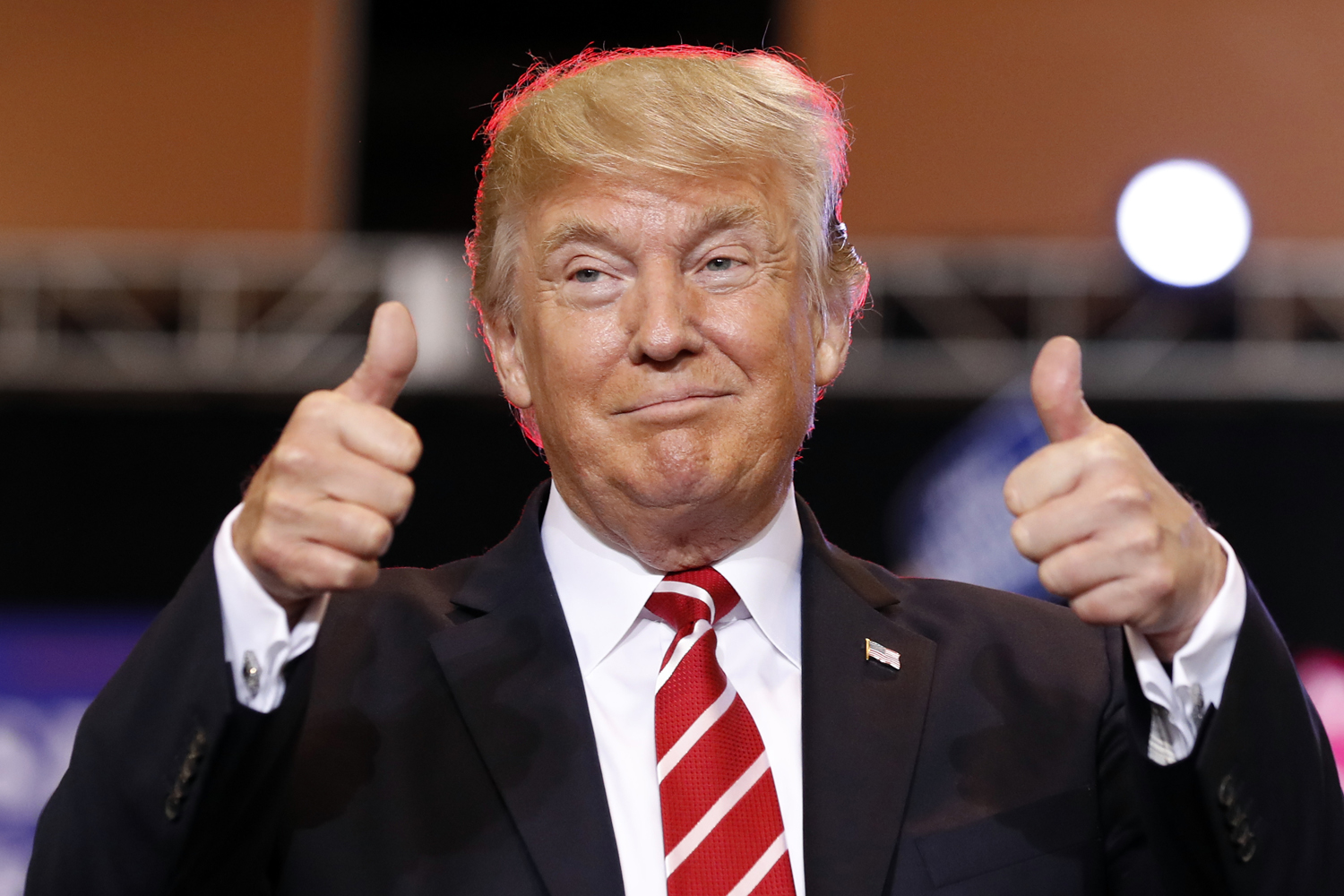Jan. 20, 2018 marks President Trump’s first year in office since he took his oath to serve Americans as the 45th president of the United States of America. In his inaugural speech before millions of Americans in Washington, D.C., President Trump made several weighty promises to his fellow Americans: “we are transferring power from Washington, D.C. and giving it back to you, the American people.” His populist approach to politics is evident in a major approach to policy-making under his administration: “From this moment on, it’s going to be America first.”
While some of the more bombastic elements of his rhetoric are more subdued after winning the election, President Trump still maintains a degree of boldness and bluntness in his rhetoric. This president is also paving the way for a new generation of presidents that Americans will likely see in the next election.
President Trump is the only president with no political experience or military service prior to taking the oath to serve as president. Although former President Obama was the first to use social media during his presidency, he is the first to use Twitter and social media networks in a key way to dispense updates about his administration, however brash they may be.
As a result of President Trump’s highly controversial rhetoric and the sexual allegations made against him, Americans have protested against his administration in protests such as the Women’s March, held on Jan. 21, 2017 in which four million people, domestically and internationally, gathered, making it the largest single-day protest in U.S. history.
In an effort to establish his legacy as an American president, rolling back several major policies launched under former President Obama’s administration characterized policy-making during President Trump’s first year. Below are some of his major accomplishments and setbacks in key sectors of the American system.
Economy
Since President Trump took office, the unemployment rate sits at 4.1 percent, comparable to the end of President Obama’s year at 4.6 percent in December 2016. For the past ten months, excluding January since President Trump assumed office on Jan. 20, his administration has added, on average, 163,000 jobs per month. Though job growth was higher under President Obama’s administration (250,000 per month in 2014, 226,000 per month in 2015 and 187,000 per month in 2016), Jed Kolko, chief economist at Indeed, said, “that’s what we’d expect at this stage of the recovery.”
Being the former CEO of privately owned international conglomerate The Trump Organization, President Trump has accumulated wealth that afforded him the liberty to make donations to varying departments in U.S. government. In Nov. 2016, the president-elect announced that he would refuse the $400,000 presidential salary, going contrary to the U.S. Code titled Compensation of the President.
In April 2017, he donated his first quarter salary, approximately $78,000, to the National Parks Service while in July 2017 press secretary Sarah Huckabee Sanders presented Secretary of Education Betsy DeVos with a $100,000 check to the Department of Education from President Trump’s second quarter salary.
[su_youtube url=”https://www.youtube.com/watch?v=pxSAhEPBnyA”]
His third quarter salary went to combatting the opioid crisis. When Hurricane Harvey hit Houston residents hard in late Aug. 2017, President Trump donated $1 million of his own money, splitting the money between twelve non-profit organizations in the area.
Signing the Republican tax cut bill into law on Dec. 22, 2017, President Trump’s tax bill delivers on cuts to corporate, estate and individual taxes. There are some changes from the proposed tax plan and the final version of the law.
Unable to simplify tax rates into three rather than the current seven rates, the GOP bill retains the seven rates though lowers the percentile for each rate (except for the lowest and second highest income earners) as follows: 10 percent, 12 percent, 22 percent, 24 percent, 32 percent, 35 percent and 37 percent. While the largest tax break will go to earners filing for a tax rate of 32 percent, 35 percent and 37 percent, who can expect at least a $50,000 tax cut this year, it’s important to note that the top 20 percent of income earners pay for nearly 87 percent of all federal income tax.
According to the Tax Policy Center, middle-class income earners within the $13,600 to $157,500 taxable income brackets will see at least a tax cut of about $900, with some receiving a tax cut of 1 percent or 1.5 percent on their taxable income. Unfortunately, the GOP bill did not make any changes to taxes American college and university students must file. However, one of the largest tax cuts in the bill is corporate tax going down from 35 percent to 21 percent, in keeping with the administration’s goals of putting Americans first and bringing back wealth on American soil, which major American companies have redirected overseas.
Healthcare
Last July, President Trump’s administration failed to repeal and replace the Obama-era Affordable Care Act, or Obamacare, as the Senate voted against the actions. Republican U.S. Representative for Pennsylvania Charlie Dent said that “one of the failures was the president never laid out a plan or his core principles and never sold them to the American people. [He] outsourced the whole issue to Congress.”
[su_youtube url=”https://www.youtube.com/watch?v=CHbWYm3IiLg”]
With a loose plan for moving forward with a new healthcare bill, many Americans would have been at risk of having no health insurance until President Trump’s administration developed a new healthcare bill. The Republican proposed plan would have made large cuts to Medicaid, which currently provides health insurance for low-income American families. Government policy experts estimated that 22 million fewer people would have insurance in 2026 under the proposed Republican initiative, 15 million fewer through Medicaid alone.
Environment
In late May, 2017, President Trump, confirmed he would withdraw the U.S. from the Paris Climate agreements. Though withdrawing the U.S., he plans to either renegotiate a fairer agreement for the U.S. or create a new negotiation entirely. If the U.S. continues its current habits of greenhouse gas emissions, by the year 2100, the earth will have heated by 0.02 degrees Celsius. Scott Pruitt, head of the Environmental Protection Agency, said “the Paris agreement handicaps the United States economy in order to win praise from the very foreign capitals and global activists that have long sought to gain wealth at our country’s expense.”
[su_youtube url=”https://www.youtube.com/watch?v=juz-GQ57_Wc”]
In October last year, the EPA proposed to repeal the Clean Power Plan, though in December there were talks of issuing a do-nothing substitute that wouldn’t make any impactful cuts to carbon pollution. “They should be strengthening, not killing, this commonsense strategy to curb the power plant carbon pollution fueling dangerous climate change,” David Doniger, director of the climate and clean air program at the Natural Resources Defense Council, said in a statement. “A weaker replacement of the Clean Power Plan is a non-starter. Americans—who depend on EPA to protect their health and climate—deserve real solutions, not scams.” While President Trump called the plan a “bad deal” for America, revisiting the topic to negotiate a replacement plan may be important in his second year in office.
Foreign Relations and Affairs
Though President Trump’s administration cannot claim the glory of doing “more in eight months than the previous administration has done in many years” against ISIS, he certainly has moved forward with President Obama’s military plans against ISIS, rightfully able to make the claim that the Islamic State has suffered its largest territorial losses since he took office.
[su_youtube url=”https://www.youtube.com/watch?v=Pr3Q2rJIVPM”]
Recently in December, President Trump announced plans to move the U.S. embassy from Tel Aviv to Jerusalem in Israel — a move that previous presidents had wanted to make, but backed out from during their administrations. U.S. Ambassador Nikki Haley defended the controversial move in an interview on “CBS News’” political programming “Face the Nation:” “What this does is basically do what we do in almost every other country, which is put the embassy in the capital city and Jerusalem is where the prime minister is, the president is, the parliament, the Supreme Court.” Though the move is a controversial one, since it may sever Turkey’s ties with Israel as well as take longer for Palestinians and Israelis to arrive at peace, the move is also a bold one.
Immigration
A shock to many Americans and highly divisive for some families, upon entering office in January, President Trump issued Executive Order 13769, known as the “Travel Ban” and later “Muslim Ban,” which was a temporary ban for 90 days on immigrants emigrating from Libya, Syria, Sudan, Iraq, Iran, Yemen and Somalia. Also for 90 days, in March, 2017, President Trump signed Executive Order 13780 which excluded lawful permanent residents from the travel ban, though added North Korea, Venezuela and Chad to the ban and removed Iraq from the list.
In October, his administration signed a more permanent travel ban, but also dropped Sudan from the list claiming “positive results” from this nation. Not all types of visas are banned for immigrants coming from these nations — only Syrians and North Koreans are banned from all visas to the U.S.
[su_youtube url=”https://www.youtube.com/watch?v=N-qTebWVZjM”]
Enacted in 2012 under President Obama’s administration, the Deferred Action for Childhood Arrivals (DACA) program allowed immigrant youths a renewable two-year period of deferred action from deportation to be eligible for a work permit. Those who immigrated to the U.S. before the age of 16 and under the age of 31 were eligible for a work permit.
President Obama’s actions tripled the wait times for visas for legal immigrants from 5 to 15 months. President Obama used his prosecutorial discretion to achieve this executive amnesty — thereby abusing his powers as president.
In an interview on Univision, President Obama admitted “until Congress passes a new law, then [he is] constrained in what [he is] able to do.” It need not be forgotten that the regulation of immigration is a matter of federal government, specifically through the legislative process Congress undertakes, as established in the Hines v. Davidowitz case in 1941.
That being said, President Trump’s administration hopes to make the Congress more accountable for the DACA program by impelling Congress to propose solutions through the lawful, legislative process. Congress had a six-month period to decide the approach it will take in resolving the DACA question. While the move was risky and may put many Dreamers at risk of deportation, this may be the catalyst for Congress to work together on enacting legislation.
Within President Trump’s first year, he visited 30 of the 50 states in America and Puerto Rico, one of its five inhabited territories. Though he has made 14 international trips thus far, he plans on limiting international travel to focus on domestic concerns.
Moving forward, President Trump’s administration will be looking to renegotiate a better deal for healthcare for Americans. While having made some concessions to public and private elementary and high schools, his administration still needs to consider reform to higher education. It will also take more effort for Congress to work together with President Trump’s administration to see more of his pledges to the American people come to fruition.
[su_youtube url=”https://www.youtube.com/watch?v=qOfzA1AQdh8″]
According to Rasmussen Reports, President Trump achieved a 44 percent approval rating after his first year — almost congruent to his approval rating since he assumed office.
In “CBS News’” ongoing series “We the People” in which CBS reporters discuss politics with Americans across the country, CBS news reporter Elaine Quijano interviewed four Americans to learn about their approval of President Trump’s administration.
Leo Smith, activist and Republican who voted for President Trump, spoke on the resurgence of white supremacists in Charlottesville: “I was horrified by the entire situation in Charlottesville. I mean, Donald Trump did not create white nationalism. He did not create the Nazis. Those people existed and so we needed to see them. They are in the light now. The way I’ve always looked at Donald Trump is that he is a catalyst to bring awareness.”
Halle Minchin-Skook, a special education teacher from Ohio and Democrat who voted for Hillary Clinton, also spoke on Charlottesville: “I think Donald Trump’s rhetoric has allowed these people to be more vocal about [white supremacy and racism.] And honestly, I think it’s a good thing because now we can do something about it.”
Steven Shook, musician and Republican who voted for President Trump, spoke about the media: “No offense to the media, but I think the media really construes [the events that took place at Charlottesville] to help place blame on the president.”
Cesar Vargas, a lawyer and undocumented immigrant, spoke on the Trump administration’s lack of aid and attention to Puerto Ricans after Hurricane Maria: “His rhetoric can also have detrimental effects like with what happened in Puerto Rico. These are American citizens who have suffered and lost everything. And then he throws napkins to them as if this is a football game…Right now we need him to be a president.”
“I think the way he speaks about other world leaders—he needs work on that. Like the ‘rocket man’ or ‘fire and fury’—you can say those things, but not using that kind of verbage,” said Minchin-Skook.
Vargas said, “I think for me it’s about bringing each other together and appreciating each other as neighbors, not as ‘oh, you’re a Republican, you’re my enemy.’”

















